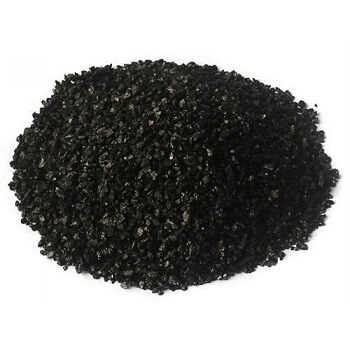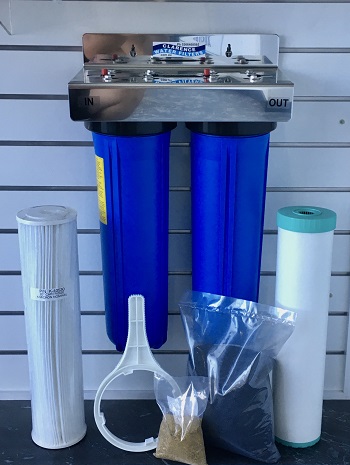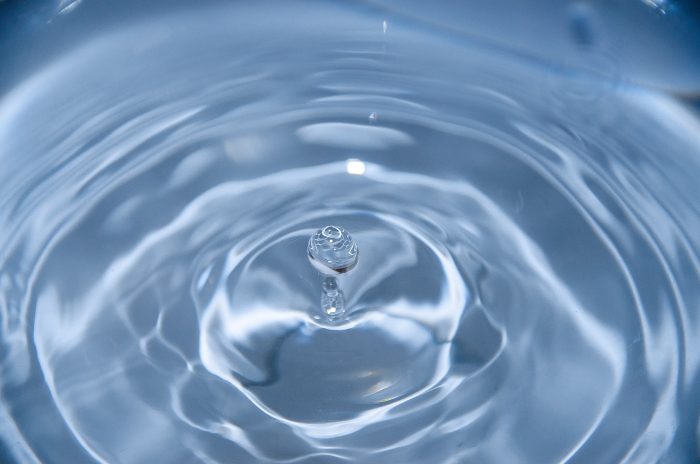
How Do Carbon Water Filters Work?
September 15, 2022 1:42 pm Leave your thoughts
Carbon is one of the most abundant elements on the planet. It resides in all living things including human beings, animals, and plants.
It is also one of the planet’s most active elements, moving through the atmosphere, the oceans, living entities, and within the earth itself in a process called the carbon cycle.
The abundance of carbon has led humans to develop thousands of ways to use it, from building structures and fuelling our cars, to providing heating and growing crops. It’s an essential element for human survival.
One of the most exciting uses for carbon can actually be found in the world of water filtration.
Carbon can be used to remove a huge range of contaminants from water including chlorine, heavy metals, pesticides, insecticides, PFAs, and petrochemicals.
It can transform contaminant water dramatically, making it cleaner, safer and more enjoyable to consume.
In this guide, we are going to delve into the world of carbon filtration. We’ll be:
- Explaining why carbon excels at contaminant removal
- Identifying the different forms of carbon
- Answering common questions about activated carbon
- Sharing some of the best carbon filters in Australia
If you have any questions at all, contact Clarence Water Filters via 02 6646 8565 or sales@clarencewaterfilters.com.au.
Contents
- How Do Carbon Water Filters Work?
- What Is Activated Carbon?
Thermal Activation
Chemical Activation - Types Of Activated Carbon
Powdered Activated Carbon (PAC)
Granular Activated Carbon (GAC)
Extruded Activated Carbon (EAC)
Impregnated Carbon
Catalytic Carbon ORC - What Do Carbon Filters Remove From Water?
Chlorine
Chloramines
Disinfection by products
Bad tastes and odours
Per- and polyfluoroalkyl substances PFAs
Herbicides and insecticides including Glyphosate Round-up
Heavy Metals
Polychlorinated biphenyls PCBs
Volatile Organic Compounds VOC
Petrochemicals
Steroid hormones including Estrogen
Pharmaceuticals and antibiotics
Microplastics - What DON’T Carbon Filters Remove From Water
Dissolved Minerals
Certain Microbiological Contaminants
Inorganic contaminants partial removal
Radionuclides - Frequently Asked Questions
How Long Does a Carbon Water Filter Last?
How Do You Know When Your Carbon Filter Needs To Be Replaced?
Can Carbon Remove Heavy Metals?
Are There Any Charcoal Water Filter Side Effects?
What Are The Disadvantages Of Activated Carbon In Water Treatment?
Can You Use A Carbon Filter For Well Water?
Is Carbon Water Filter Replacement Hard?
How Much Does Carbon Filter Cost?
What Is The Best Activated Carbon Water Filter?
Is A Carbon Water Filter Jug All I Need? - Wrapping Up

How Do Carbon Water Filters Work?
Carbon has been used to filter water for thousands of years. It primarily works using the scientific principle of ‘adsorption’.
Adsorption is the capability of any material to attract and hold onto molecules.
When water flows through a material with a high adsorption capacity some of the contaminants it contains can become ‘stuck’ to its surface and removed from the water.
Carbon has a particularly strong adsorption capacity, which makes it extremely useful for filtration purposes.
The pores on the carbon’s surface can also catalyse (break apart) more complex chemicals. Certain forms of carbon are more effective at catalysing chemicals than others.
Blocks of compressed carbon will also use mechanical filtration to remove contaminants. The carbon will block large sediment particles from passing through, like a sieve.
Many types of carbon can be used to filter water including wood, coal, coconut shells, bamboo, sawdust, willow peat, peach pits, and coir.
What Is Activated Carbon?
Most modern carbon water filters will use activated carbon, also called activated charcoal.
Activated carbon refers any form of carbon that has been modified to have more pores on its surface. This gives the carbon a larger surface area, which provides for improved absorption capacity and chemical catalysing capabilities.
In other words, it makes the carbon faster at removing impurities and increases the total chemical reduction capacity of the carbon.
The amount of surface area on activated carbon is astounding. A single gram of activated carbon has about 3 kilometres of surface area. This provides plenty of room for capturing contaminants.
Activated carbon can be made from virtually any carbonaceous source material. However, the most common choices are crushed coconut shells, wood, and coal.
There are two methods for activating carbon: thermal and chemical activation.
1. Thermal Activation
With this form of activation, hot gases are applied to the carbon which causes additional pores to. This increases its adsorption and chemical catalysation ability. This process is carried out using an inert gas like carbon dioxide, nitrogen or argon.
The entire process involves several steps:
- Cleaning/processing
- Moisture reduction
- Removal of volatile compounds
- Carbonisation
- Final steam treatment (activation)
2. Chemical Activation
Chemicals are added to the raw source material before it begins the carbonisation process. In most cases, it will involve salt, acid or a strong base solution. The carbon is then exposed to heat which causes it to develop more pores, activating it.

Types Of Activated Carbon
There are many forms of carbon available, categorised by processing method, application, and size. The most common forms include:
Granular Activated Carbon (GAC)
Granular activated carbon consists of clumps of carbon, typically 0.4 to 3mm in size. GAC is ideal for water filtration applications where a fast flow rate is needed. Also useful for absorption of vapours and gasses from the air.
Granular activated carbon is often used inside of refillable filter cartridges. The cartridge has sediment pads to keep the carbon from flowing through into the filter head.
Powdered Activated Carbon (PAC)
Very fine particles of ground or crushed carbon that can be added directly to water or used in a water processing unit.
Extruded Activated Carbon (EAC)
Also referred to as carbon block filters. Combines powdered activated carbon with a binding agent to create a solid piece of carbon filter media.
Carbon block filters have a low pressure drop, minimal dust content, and excellent mechanical strength. Compression of the carbon can also make the filter capable of blocking fine sediment particles, which can include heavy metal particles on filters with smaller micron ratings, like the WC04.
Most carbon block filters are cylindrical, with a hollow core. The incoming water will move through the walls of the filter, then through the hollow core and out of the filter head outlet.
Impregnated Carbon
Carbon can be impregnated with a variety of materials to enhance its capabilities. Common types of impregnated carbons include:
- Silver impregnated carbon
Silver is bacteriostatic, so it can kill or incapacitate bacteria inside of the filter media and filter housing. This reduces the risk of bacterial growth occurring in your filter system when treating unchlorinated tank/bore water. - KOH Impregnated Coal Based Carbon (Potassium Hydroxide)
Excels at reducing sulfide-rich odours typical of municipal sewage treatment, pulp and paper mills, and refineries. Also reduces Nitrogen Dioxide and Nitrogen Oxides. - Copper Impregnated Carbon
Copper impregnated carbon is more resilient against high temperatures compared to standard carbon. Often used to filter volatile organic compounds and other chemicals from air.
Catalytic Carbon (ORC)
Catalytic carbon is a form of activated carbon which has received additional processing to further increase the number of pores it contains.
The additional pores make it capable of removing chemicals faster and having greater storage capacity. It can also catalyse complex chemicals like chloramines more easily. In fact, if chloramines are of concern to, catalytic carbon should be used in your filtration system.

What Do Carbon Filters Remove From Water?
Carbon filters can reduce a wide range of contaminants from air and water. From water, this includes:
Chlorine
Chlorine is added to treated water supplies to kill or incapacitate bacteria, protozoa, algal spores, viruses, and cyst parasites (cryptosporidium, giardia etc). Unfortunately, it gives the water a bad taste/odour. Disinfection by-products (DBPs) are also created as the chlorine interacts with decaying matter and other chemicals (more on those in a moment)
Chloramines
Chloramines are a combination of chlorine and ammonia. Water authorities are increasingly turning to chloramination as it provides longer residual protection, so water remains sanitised for longer. Unfortunately, chloramine molecules are harder to remove from water than chlorine, because they are more complex. If you have chloramines in your water, we’d recommend the use of Catalytic Carbon (ORC) as it has more surface reactive sites.
Disinfection by-products
Chlorination of water can generate hundreds of new compounds and chemicals. Some of the DBHs created are toxic, like Trihalomethanes. The good news is that carbon filtration can also reduce the levels of DBHs in the water.
Bad tastes/odours
Carbon is extremely effective at removing bad tastes and odours from water. There are also speciality carbons which remove unusual smells like Hydrogen Sulphide.
Per- and polyfluoroalkyl substances (PFAs)
Nicknamed ‘forever chemicals’ due to their ability to persist within the natural environment and the human body. PFAS can increase the risk of many conditions including Thyroid disease, Liver damage, Breast cancer, Kidney cancer, Inflammatory bowel disease, and Testicular cancer. Fortunately, Carbon is effective at removing PFAs from water.
Herbicides and insecticides including Glyphosate (Round-up)
Although Australian water authorities do their best to limit agricultural activities around water reservoirs, herbicides and pesticides can still make their way into town water. If you have a tank, you may have this type of chemical contaminant due to aerial spraying. Fortunately, carbon does a fantastic job of adsorbing both herbicides and pesticides.
Heavy Metals
Fine carbon block filters are capable of removing lead, mercury and other heavy metals. It’s important to note that standard granular activated carbon cannot remove heavy metals.
Polychlorinated biphenyls (PCBs)
PCBs are carcinogenic chemical compounds, which were often used in industrial and consumer products prior to the 1980s. Activated carbon is very effective at removing it from water, with high-quality carbon blocks having a removal rate of up to 99.99%. Read more about the effectiveness of carbon on Polychlorinated biphenyls (PCBs).
Volatile Organic Compounds (VOC)
Volatile organic compounds are organic chemicals that have a low boiling point and high vapor pressure. You can find VOCs in many solvents, adhesives, cleaning supplies, paints, and other chemical solutions. Some VOCs are been found to be hazardous to humans. Fortunately, carbon filtration has been shown to effectively reduce Volatile Organic Compounds (VOC) in water.
Petrochemicals
Petrochemicals refer to any chemical developed from natural gas or petroleum. You can find petrochemicals in detergents, polyester fibres, nylon, acrylics, polythene and man-made plastics. Activated carbon has been shown to remove most petrochemicals from water.
Steroid hormones including Estrogen
Steroid hormones are quite robust and can persist in water for a long time. Unfortunately, consuming them can have an unexpected impact on a person’s health. Carbon can trap a wide range of steroid hormones including Estrogen.
Pharmaceuticals and antibiotics
Our local waterways are increasing polluted by pharmaceutical compounds and anti-biotics. Unfortunately, this increases the risk that some of these compounds can make it into our drinking water supply. Fortunately, carbon has been shown to be capable of trapping both pharmaceuticals and antibiotics.
Microplastics
Microplastics are extremely small pieces of plastic debris created from plastic objects breaking down. Scientists believe that they may have a negative impact on human health if ingested.
Although most microplastics are between 2-5mm in size, they can eventually become quite small. As of 2017, the smallest microplastics found are 1.3 micrometres (1.3 microns) in size. A fine carbon block or sediment filter is very effective at trapping particles of this size.

What DON’T Carbon Filters Remove From Water?
Although activated carbon is one of the most effective forms of media for contaminant reduction, there are a few things it can’t do. It won’t remove:
Dissolved Minerals
Carbon doesn’t remove dissolved minerals like calcium, magnesium, phosphorous, potassium, and sodium. This is a good thing in one respect, as it means your water retains mineral content, which is good for your health.
However, if you are in a part of Australia with high TDS, you may be experiencing limescale build-up, which could damage appliances and plumbing fixtures. Your carbon filter won’t help to prevent this on its own.
Fortunately, there are some other options which can reduce limescale including KDF and Polyphosphate. Contact us to learn more.
Certain Microbiological Contaminants
Carbon filters will not remove very small bacteria and viruses, which can sometimes be found in untreated water. For their removal, you will need a UV system (kills all pathogens) or a ceramic filter (traps most bacteria).
Some pathogens can only be removed using specific types of carbon filters. For example, you would need to use a sub-micron carbon block (1 micron or smaller) to remove Cyst parasites like Cryptosporidium, Giardia, and Cyclospora.
If you are using untreated water, you could also chlorinate it to kill any pathogens, then use carbon filtration to remove the chlorine.
Inorganic contaminants (partial removal)
Only certain carbon filters are capable of removing inorganic contaminants like arsenic and asbestos. To reduce these contaminants, you’ll need a fine carbon block filter (1 micron or lower). A high quality carbon block filter is required to handle these contaminants.
Radionuclides
Radionuclides are unstable radioactive forms of elements including radon, uranium, radium, lead and polonium. There are specific carbon block filters designed to trap these types of contaminants.

Frequently Asked Questions
How Long Does a Carbon Water Filter Last?
The lifespan of a carbon filter will vary based on a few factors:
- How much water you use
The more water going through the filter, the more rapidly its capacity is used up. - The quality of the water
The level of sediment and chemicals in the water - The type of carbon used in the filter
Catalytic carbon has more capacity than standard activated carbon - How fine the filter is
Carbon block filters may clog up faster compared to a granular activated filter. - The size of the filter
The larger the filter, the more capacity it has
However, in general terms:
10-inch carbon filters on dedicated drinking water tapes will last about 12 months.
20-inch carbon filters for whole house filtration systems will last 6-9 months.
How Do You Know When Your Carbon Filter Needs To Be Replaced?
- Your flow rate begins to slow
- The taste or odour of your water changes
- There is visible sediment in the filter
- The colour of your water changes.
Can Carbon Remove Heavy Metals?
We stock several filters capable of reducing heavy metals, including:
Are There Any Side Effects From Using A Charcoal Water Filter?
There are no side effects to use a high-quality activated charcoal water filter. The only things a carbon filter will do to your water are:
- Remove bad taste/odours
- Adsorb a wide range of chemicals, removing them from the water
- Block sediment particles larger than the micron rating of the filter size
- Block certain cyst parasites including cryptosporidium, Cyclospora, and Giardia, if the filter is a sub-micron carbon block
However, it’s important to note that all water filters have a limited lifespan.
If you have a carbon water filter and keep it installed for many years, it will begin to let contaminants through and may even begin to harbour bacteria inside its casing.
That is why we always recommend that carbon water filters should be left in place for no longer than 2 years.
Are There Any Disadvantages Of Using Carbon Water FIltration?
There are very few disadvantages of using an activated carbon filter. The only draw backs are:
- The initial cost of purchasing a water filter system
- Installation time
- Filter replacement costs
But given the capabilities of carbon filters and the fact you can purchase a high-quality carbon filter for as little as $30, it’s hard to find a reason to not use carbon filtration.
Can You Use A Carbon Filter For Well Water?
Absolutely. Carbon filtration can be used on town, tank, dam, river, creek, and well water. When used on well water, it can help you improve the waters taste/odour and remove chemicals which may entered the water.
If you are using a fine sub-micron carbon block, it will also take out cryptosporidium, giardia and Cyclospora from your well water.
However, it’s important to understand that you may need additional sediment filtration when using a raw, untreated water. This will trap particulate contaminants like dirt, sand, and silt, before they can block the carbon filter.
Is Carbon Water Filter Replacement Hard?
Carbon filters come in many shapes and sizes. Some are fully enclosed and simply screw into your fridge or a filter head like a light bulb. If you can install a light bulb, you’ll have no problems installing one of these carbon filters.
Other carbon filters are placed inside of a cannister, which is then screwed onto a filter head. They are also simple to install, but involve slightly more maintenance as you need to clean the housing and change o-rings every few years. However, they are still extremely simple to use.
If you have a refillable filter that contains granular activated carbon, you will also need to dump out the exhausted carbon when you change the filter. You can use it on the garden or put it into your green bin.
How Much Does Carbon Filter Cost?
The price of carbon filters varies dramatically based on their size and capabilities.
Currently, a budget 10” x 2.5” Granular Activated Carbon Filter is $22.50 and a budget 10” x 2.5” Carbon Block Filter is around the $22.00 mark. Incredibly affordable, especially given the incredible number of contaminants they can remove from water.
More expensive American made 10” x 2.5” Carbon Blocks like the WC04 are closer to the $50 mark.
Fridge filters start around the $40 mark and go up from there.
A refillable 20” x 4.5” Whole House Granular Activated Carbon Filter is less than $80 and bags of carbon to refill it are between $30 to $45. Carbon block filters for whole house systems are close to the $80 price point.
If you are unsure which type of filter would be ideal for your budget and filtration requirements, give us a call.
What Is The Best Activated Carbon Water Filter?
The best activated carbon water filter will vary based on:
- Your filtration goals
- The quality of your water
- How much water you use and what flow rates you need
- Your budget
However we often find ourselves recommending the following products:
- For under-sink systems with a dedicated tap (town water)
WC04 0.45 Micron Carbon Block - For under-sink systems with a dedicated tap (tank water)
GTS1-10 (1 Micron silver impregnated carbon block) or
Doulton Ultracarb (if bacteria or heavy metal removal is also needed) - For high flow under-sink systems (water goes through a standard tap)
AP1025KDF/GAC - For Coffee Machines
3M™ HC351-S with Nep Head or
Brita Cappuccino Espresso Filter Kit or
3M 10” x 2.5” 1025PHOS/GAC - For 20” x 4.5” Whole House Systems (town water)
20” x 4.5” Refillable GAC Filter or
20” x 4.5” 5 Micron Carbon Block - For 20” x 4.5” Whole House Systems (tank water)
20” x 4.5” Refillable Silver GAC Filter or
20” x 4.5” 5 Micron Silver Carbon Block
As you can see, there are quite a few choices available when it comes to carbon filters. If you’d like some assistance, contact us today on 02 6646 8565 or sales@clarencewaterfilters.com.au.
Is A Carbon Water Filter Jug All I Need?
Many people will purchase a carbon water filter jug to improve the taste and odour of their drinking water. Unfortunately, these types of filters are not always effective due to them having such a tiny amount of carbon.
When you use a small jug filter means there is less contact time between the water and the carbon. This limits the carbon’s opportunity to remove contaminants from the water.
It will also reach maximum capacity much faster than a larger filter, so you will either be changing filter frequently or consuming chemical contaminants without realising it.
Wrapping Up
As you can see, carbon water filters are a very useful tool when it comes to removing chemical contaminants and improving the odour/flavour of water. If you would like to learn more, contact us today!
Clarence Water Filters
02 6646 8565
sales@clarencewaterfilters.com.au.
Tags: Carbon, Catalytic Carbon, Explainer, Filtration Guide, Granular Activated Carbon, How Do Filters Work
Categorised in: Product Features, Water Filtration
This post was written by Paul
